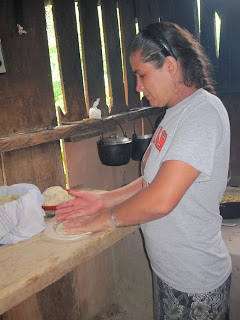In July 2010 I spent 6 weeks living with 2 different Nicaraguan families in the village of ‘La Naranja de Tiacan’ in the protected area of Miraflor, just north of Esteli. During this time I was a project manager for Raleigh International working on a community centre building project. Part of the experience involved living and getting involved with day-to-day life with the community. This experience was incredible and one I will never forget. For me, food is a major part of experiencing new cultures and different ways of life and so this post aims to give you a taste of what life is like in rural Nicarauga.
Life is simple and the food reflects this. Much more of the daily routine is around basic survival tasks such as cooking, cleaning, feeding the children, and then earning a living perhaps from farming or baking and selling your produce. The first family I lived with had their own land where they grew a few fruit and vegetables and herbs, as well as a large outdoor oven which the mum – Elizabeth, used for baking a variety of goodies which she sold to both her and neighbouring communities and even as far as Esteli. The second family I lived with had their own large farm for animals, vegetables and fruits. Both mums took pride in their cooking and were always delighted if you asked for seconds – providing you with a larger portion than the first!
It is incredible the amount of time and effort that goes into preparing food for the family each day. Each morning my mum would get up at or before dawn (between 5 and 6am) and start the day by preparing enough corn tortillas for the day. I had a go at making these myself and they certainly make it look easier than it is! For a family of 2 children and 2 adults the mum used to make at least 60 tortillas each day – ensuring there were plenty for every meal!!
Breakfast was served around 7/7.30 am and you could always guarantee on a healthy chunk of cuajada cheese, and a plate of fresh tortillas, and then perhaps frijoles, arroz, (or gallo pinto) or huevos (eggs) to accompany along with a traditional Nicaraguan coffee – black and SWEET! I will never forget my mum’s face when I asked for mine ‘sin azucra’ (without sugar), she seemed to think it was the strangest request in the world and after this she assumed that I didn’t like sugar in ANYTHING (i.e. I don’t like cakes?!). This shows how foreign it is to drink coffee without sugar!
After a hot mornings work at the sight we would be faced with (to our dread admittedly) a boiling hot soup of chicken, ayote, potatoes or yuka and onions. As nice as the soup was it was not always welcome in the heat of the day! Other lunches (which we loved) would include gallo pinto, plantain, malanga chips, and if you were lucky avocado or tomato. Again, without fail a healthy plate of tortillas awaited!
In the evenings, again similar food, perhaps some chicken, or beef if it was a special occasion, papas fritas occasionally. We would also be given yummy roasted sweet bananas which occasionally we would add a little nutella to (a treat from outside the village!). In addition we tried the local chocolates - samba, and became a little addicted to these small pieces of heaven!
The main thing I noticed about food in rural Nicaragua was the lack of fresh fruit and vegetables. The most common vegetable we ate was ayote and chayote. A handful of times we were lucky to have fresh tomato and avocado however, our mum explained that these were expensive and had to be bought from Esteli or Yali. However, they love their food, especially the cuajhada cheese!
If you get the chance to visit Nicaragua I would really recommend living with a local family for the opportunity to experience the cuisine and lifestyle, its an unforgettable experience with the chance to meet and make friends with some of the friendliest, warm and most generous people I have ever met. Click here to view some of the recipes from my time in La Naranja.
If you get the chance to visit Nicaragua I would really recommend living with a local family for the opportunity to experience the cuisine and lifestyle, its an unforgettable experience with the chance to meet and make friends with some of the friendliest, warm and most generous people I have ever met. Click here to view some of the recipes from my time in La Naranja.



































